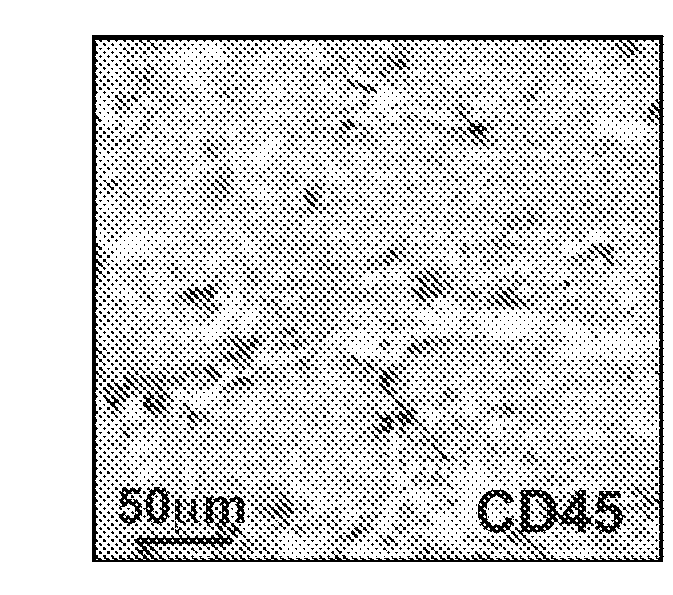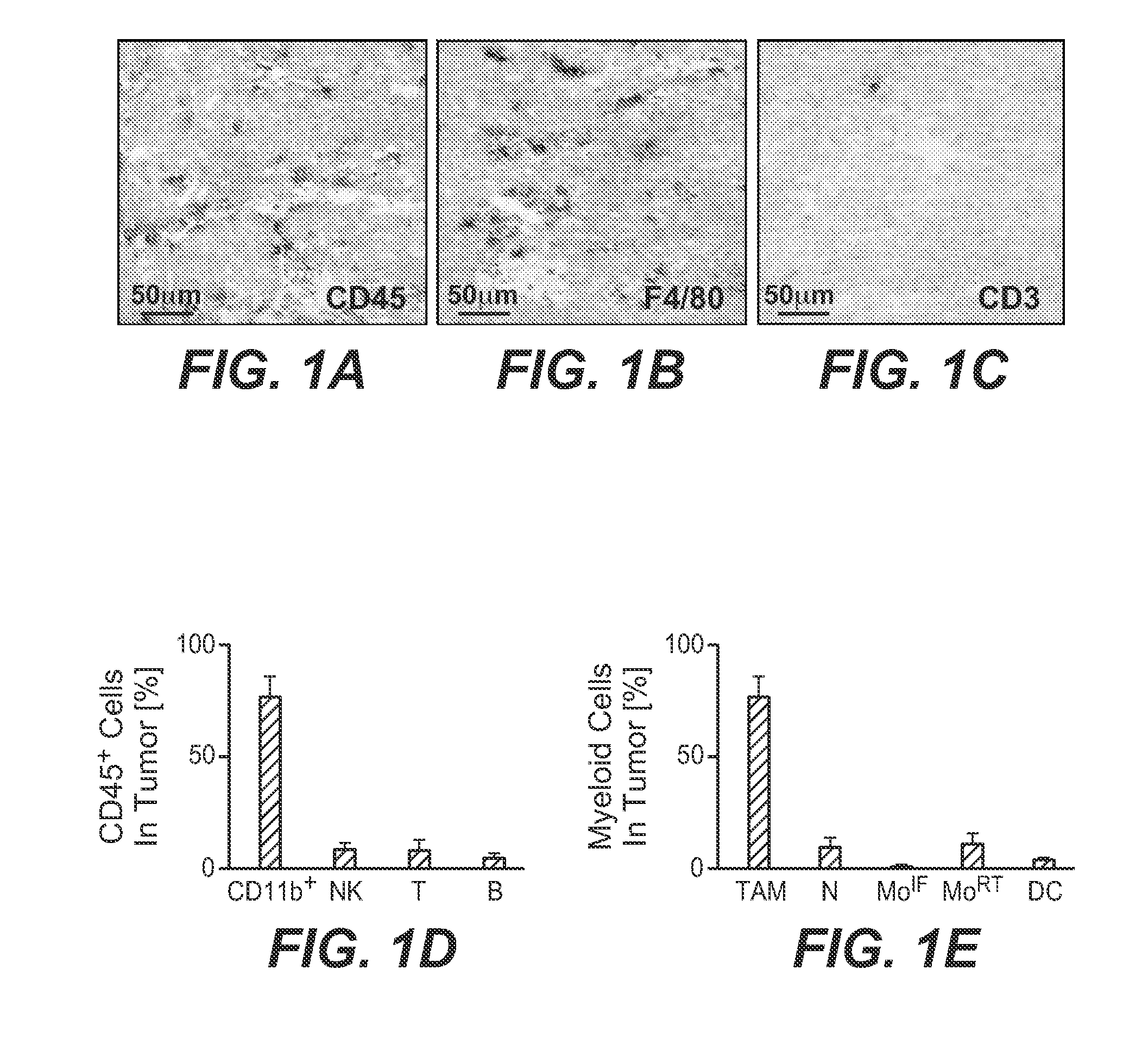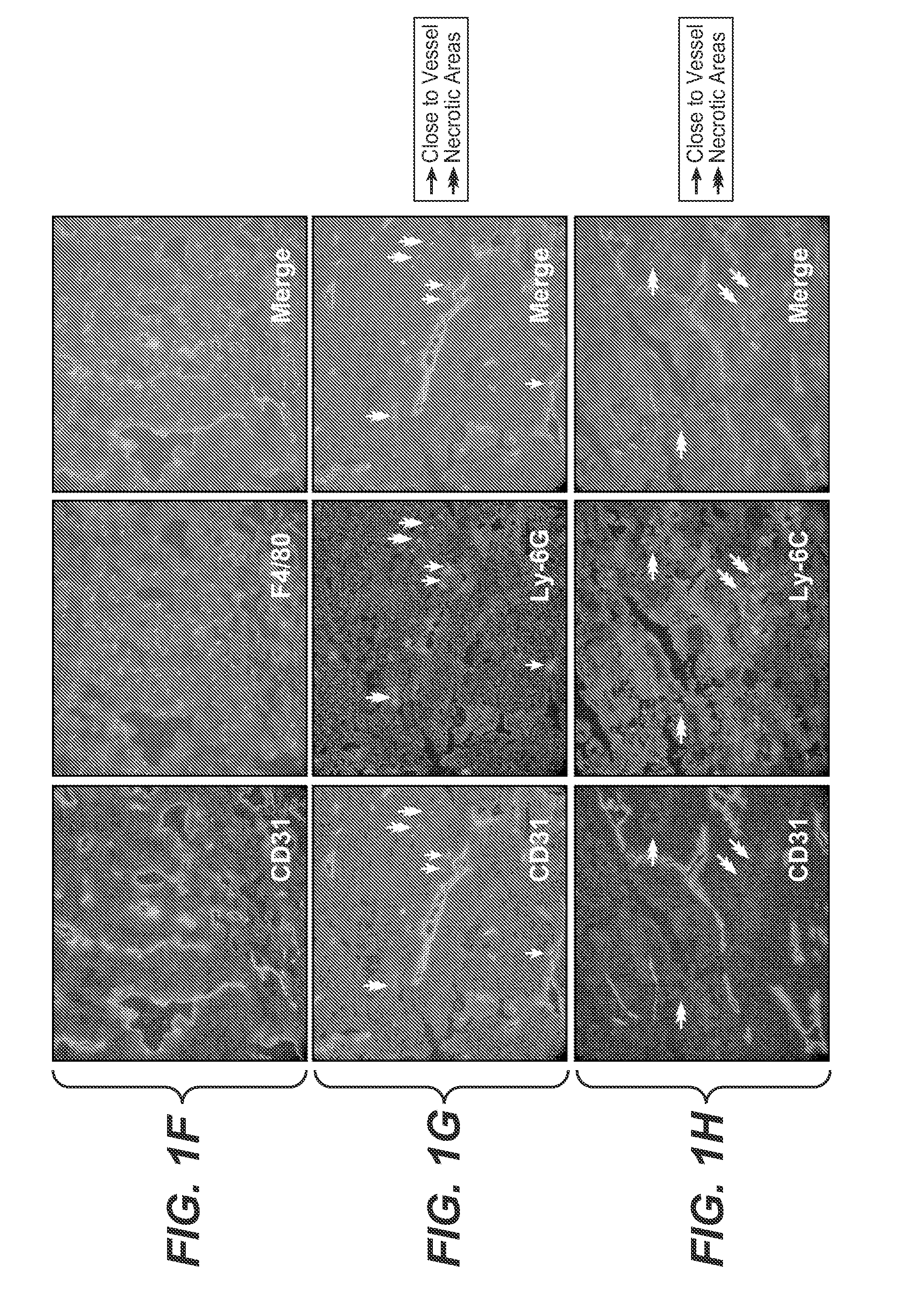Treatments and diagnostics for cancer, inflammatory disorders and autoimmune disorders
a cancer and inflammatory disorder technology, applied in the field of tumor growth, can solve the problems of impaired antigen presentation, poor prognosis, and high levels of macrophage infiltrate breast carcinoma and other human tumors, and achieve the effects of inhibiting tam activity, and modulating tam viability or activity
- Summary
- Abstract
- Description
- Claims
- Application Information
AI Technical Summary
Benefits of technology
Problems solved by technology
Method used
Image
Examples
example 1
Composition and Localization of Myeloid Infiltrates
[0274]The composition and localization of immune infiltrate in MMTV-PyMT induced mammary tumors was assessed by immunohistochemistry. Wild-type mice sensitive to Friend leukemia virus B strain (“FVB”) were purchased (Charles River) and mice comprising MMTV.PyMTtg or MMTV.Her2tg tumors in an FVB background were bred in pathogen-free facilities. Tumors from MMTV.PyMTtg mice were embedded in OCT solution and frozen. Frozen sections were cut into 5 micron slices, dried at room temperature, and fixed with ice cold acetone using standard procedures. Endogenous peroxidase was quenched with glucose oxidase for 60 minutes at 37° C. The sections were rinsed with PBS, and endogenous avidin and biotin blocked with an Avidin Biotin Blocking Kit (Vector) according to the manufacturer's instructions. The sections were blocked with 10% rabbit serum in 3% BSA / PBS for 30 minutes at room temperature, and then incubated with the appropriate antibody di...
example 2
Characterization of TAM
[0281]A. TAM Express CD11c and Langerin and Display Features of Professional Antigen-Presenting Cells
[0282]Both macrophages and dendritic cells (“DC”) have the ability to capture antigens and to present them to T cells. To better understand the role of TAM in the regulation of T cell responses, the expression of genes often associated with antigen presentation within tumors was assessed. Immunohistochemical analyses for markers typically expressed on myeloid or DC cells were performed on TAM according to the methods described in Example 1. Rat anti-F4 / 80 antibody was obtained from Serotec, rat anti-CD11b antibody was obtained from eBioscience, and rat anti-CD11c antibody was obtained from Pharmingen. Immunohistochemistry for anti-human langerin (CD207) was performed generally as described in Example 1, but the tissue sections were dewaxed and subjected to antigen retrieval in Target Retrieval buffer (pH 6.0, Dako Cytomation) using Lab Vision's PT Module at 99°...
example 3
TAM Chemokine and Cytokine Profile
[0292]To further understand how TAM might influence tumor growth and progression as well as anti-tumor immune response, the cytokine and chemokine profiles of TAM were assessed. Microarray analyses were performed as described in Example 2 for a selected set of genes: chemokines CCL2, CCL3, CCL4, CCL5, CCL7, CCL8, CCL17, CXCL1, CXCL9, CXCL10, CXCL16, and KC and cytokines IL-1α, IL-1β, IL1 RA, TNFα, TGFβ, and LTβ. Peritoneal macrophages and TAM displayed distinct chemokine and cytokine profiles (see Table 2 and FIG. 7A). TAM produced larger amounts of mRNA encoding certain chemokines, for example CCL2, CCL3, CCL4, CCL5, CCL7, CCL8, CCL17, CXCL1, CXCL9, CXCL10, CXCL16, and KC (see Table 2 and FIG. 7A) as compared to bmDC. Such chemokine expression should attract a variety of lymphocytes, including those typically found in tumors such as monocytes, immature DC, NK cells and T cells. Enhanced levels of mRNA encoding IL-1α, IL-1β, IL-1 RA, TNFα and LTβ in...
PUM
| Property | Measurement | Unit |
|---|---|---|
| Time | aaaaa | aaaaa |
| Surface | aaaaa | aaaaa |
| Cell growth | aaaaa | aaaaa |
Abstract
Description
Claims
Application Information
 Login to View More
Login to View More - R&D
- Intellectual Property
- Life Sciences
- Materials
- Tech Scout
- Unparalleled Data Quality
- Higher Quality Content
- 60% Fewer Hallucinations
Browse by: Latest US Patents, China's latest patents, Technical Efficacy Thesaurus, Application Domain, Technology Topic, Popular Technical Reports.
© 2025 PatSnap. All rights reserved.Legal|Privacy policy|Modern Slavery Act Transparency Statement|Sitemap|About US| Contact US: help@patsnap.com



